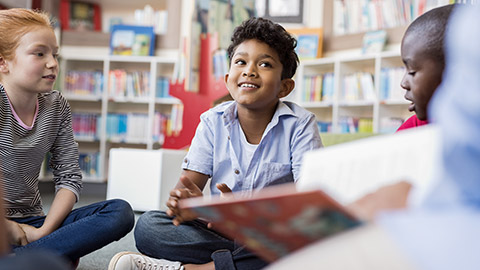Educators play a key role in supporting children’s learning and development. Respectful relationships with children are the foundation that supports this process. Through respectful relationships, children develop the confidence they need to learn, express themselves and tackle problems and challenges.
Educators demonstrate respect for children through their communication and behaviour, not only with children themselves but also with their families and communities. The learning environment itself – such as resources, routines, spaces and learning programs – also plays a key role in supporting children.
By the end of this topic, you will understand:
- How to implement practices that empower children and support children’s agency
- How to acknowledge children’s efforts and achievements
- How to identify techniques that an educator can use to comfort children who are crying or distressed
- How to respond positively to children’s varying abilities and confidence levels
- How to organise spaces, resources and routines to reduce the potential for children’s stress and frustration
- How to develop a learning program that is responsive to individual children’s culture, strengths, interests and knowledge
- How to support practices that honour children, their family and their communities.
We need to provide [children] with opportunities to develop the confidence to explore their world, to ask questions, to express ideas, to get things right, but also to understand that you can be wrong and learn from mistakes.Luke Touhill, Early Childhood Australia

According to the United Nations Convention on the Rights of the Child, children have the right to actively participate in all the things that affect their lives, including their education and care.
To actively participate in their lives, children need agency. Agency is the capacity to act independently and make choices freely. When someone has a sense of agency, they feel in control of the things that happen around them and feel like they can influence events. Having a sense of agency for a child in the early years is very much linked to a sense of belonging.
As an educator you can support children’s agency and empower them in a range of ways, depending upon their age and stage of development. For example, you can give preschool-aged children the opportunity to make decisions about their own learning.
WATCH
Although created for parents, the following almost 6-minute video explains what agency is and why it is so important for children: (The video starts at 0:40.)
Little.ly Early Learning Centre – Encouraging agency
Jerome is five years old. He went to a reptile park on the weekend and is telling Alma all about the turtles he saw. ‘Turtles have a shell,’ he says to Alma.
‘They do,’ Alma replies. ‘So do tortoises.’
‘What’s a tortoise?’ Jerome asks.
‘A tortoise is like a turtle, but it lives on land rather than in the water.’
‘Does it have a looooong neck? Jerome asks, extending his arms outwards.
‘I think so. Would you like to learn more about turtles and tortoises?’ Jerome nods. ‘Okay,’ Alma replies. ‘How do you think you could learn about that?’
‘YouTube?’ Jerome replies.
‘That’s a good idea. Do you want me to help you?’
‘Yes, but I know the buttons,’ Jerome says.
In this case study Alma recognises Jerome’s interest and responds with an open-ended question, encouraging Jerome to think further regarding what he wants to learn and how he wants to learn. Alma scaffolds and supports his learning by following his lead.
The following table features a selection of methods you can employ to support children’s agency and empower them to actively participate in early childhood settings.
|
Age Group |
Ideas for Supporting Children’s Agency and Empowerment |
|---|---|
|
0–2 years |
|
|
3–5 years |
|
Resource
To learn about how you can utilise routines with young children, visit Raising Children Network.
Check your understanding
Read the following scenarios, then select the action that support children’s agency the best:
You can also use the environments where children play and learn to promote their agency:
- Involve children in decisions about whose artwork will be displayed in the centre and when it will be taken down.
- Supply equipment and furniture that helps children do things for themselves, such as chairs that allow their feet to reach the floor and hooks that they can reach.
- Create environments that allow children to move freely between indoor and outdoor environments.
- Provide a range of resources and materials so children can make their own decisions about what they want to do and which resources they want to use (e.g. an art and craft space with textiles, pencils, ribbons, coloured paper, sticker dots, etc.).
On the ACECQA website, there are some valuable resources for educators to check out about how they can establish and create agency in their daily practice when interacting with children.

Children cry for a range of reasons that vary based on the child’s age. When comforting a crying infant or child, be calm and gentle.
The following table details key reasons different age groups cry and how you can provide comfort for those age groups:
|
Age Group |
Reasons for Crying |
How to Comfort a Crying Infant or Child |
|---|---|---|
|
0–12 months |
The baby is:
|
|
|
1–3 years |
The toddler is:
|
|
|
4–5 years |
The child is:
|
|
Resource
A checklist for dealing with crying babies is available on the Raising Children Network.

You can acknowledge children’s efforts and achievements by praising and encouraging them. When you praise a child, you tell them that you like what they are doing or how they are behaving. When you encourage a child, you are praising them for their effort.
When you praise a child for something they are doing well, you show them how to think positively about themselves and recognise when they do well. When you praise a child for their effort, you motivate them and encourage them to try harder next time. Praising a child for effort also helps them see that trying to do something is good and will help them feel more confident about tackling challenging tasks and situations in the future.
Some children need more encouragement than others, especially if they are less confident about themselves and their abilities.
WATCH
The following 4-minute video explains what good praise is in order to encourage children effectively:
Case Study
‘Descriptive praise’ is a meaningful form of praise. It involves telling a child what it is that you like about what they are doing or how they are behaving.
For example, if you want to praise Marco for sharing the slippery slide with Anoush, you could say, ‘Marco, I really like the way you’re sharing the slippery slide with Anoush.’ This is descriptive praise because it tells Marco exactly what you like about his behaviour.
On the other hand, if you just say, ‘Good boy, Marco,’ it does not help him understand what he has done well. This is non-descriptive praise.
You can build on children’s learning by recognising when they learn something significant and extending upon that learning. For example, if a child talks to you about what they are doing while they are playing, introduce new and different props and materials. You can extend children’s learning by guiding them through an activity or task that is too difficult for them to do alone. Prompt the child and ask them questions as they work their way through challenging tasks or activities.

You can help to reduce children’s stress and frustration by properly organising the routines, spaces and resources within your centre. If you want to adapt, change or tweak a routine, space or resource, you need to make sure you have the authority to do it – in other words, any changes you make need to be within the scope of your responsibility.
Routines to reduce stress and frustration
Routines are practices or events that happen every day, and they help children feel safe and secure. Routines around food and sleep also help to ensure children’s overall health and well-being.
Routines in early childhood settings include:
- Saying hello and goodbye when arriving or departing the centre
- Washing hands before eating
- Cleaning and setting tables for meals
- Having sleep and rest times
- Toileting and nappy changing
Ways you can organise routines to reduce children’s stress and frustration include:
- Give children choices during routines and transition times.
- Provide adequate warning for children in relation to transitions to provide time for them to prepare themselves and are aware of what’s is happening next.
- Plan transitions carefully in a way that supports children’s individual preferences and minimises anxiety and stress.
- Adjust routines to meet children’s needs and reflect the different ways that families do things, such as the foods they eat, how they prepare and serve food and sleeping practices.
- Pay attention to how the child is feeling and what they are thinking when they are engaged in routines and transitions – consider how the environment might be contributing to their stress and anxiety (e.g. a busy, crowded or loud environment).
So how do routines help with stress and frustration? Routines work as a behaviour management strategy as they provide a rhythm and let children know there are things they can count on. Also, embedding routines help the children to keep calm.
For example, if children are engaged in free outdoor play, it would be ineffective telling them randomly to finish the play and go to have lunch, then have an afternoon sleep. It is advisable to have a set daily routine where children know what activities comes when and give a warning before transitioning to the next activity. You can introduce a pack-away song to help children focus on the next activity, have a short group-time with action songs to bring all children together, then transition them to the bathroom, then to having a meal, then transition them to quiet activities and/or sleep.
WATCH
The following 3-minute video explains the importance of routines in a child’s day and how this can help children when dealing with stress and frustration and building resilience. Your role as an educator has such an impact on children.
Spaces and resources to reduce stress and frustration
The physical environments where children live, learn and play can greatly impact upon their emotional well-being and stress levels.
The following table provides some examples of factors that can impact children’s levels of stress and frustration, along with example methods for addressing these stressors.
|
Stressor |
How to Address the Stressor |
|---|---|
|
Noise |
|
|
Crowding |
|
|
Lighting |
|
|
Physical space |
|
|
Resources |
|
Check your understanding

High-quality early childhood education and care programs support all areas of each child’s learning and development and are responsive to a child’s culture, strengths, interests and knowledge.
Strong, trusting relationships with families are very important when developing a responsive learning program. These types of relationships will help to ensure families share information and knowledge with you about the child.
To be responsive to children’s cultures, learning programs should be developed in consultation with local families and communities. This is especially important when you are working with Aboriginal and Torres Strait Islander children and families. The best way to consult with these families and communities will depend upon the context. However, the methods used must be founded upon a respect for diversity.
Here are some of the ways you can ensure a learning program is responsive to each child’s unique strengths, knowledge, interests and culture:
- Have daily conversations with parents and families about the child’s strengths, knowledge and interests.
- Use a communication book so parents and educators can share information about the child’s strengths, knowledge and interests.
- Work in partnership with other professionals involved in the child’s care (e.g. speech therapists, early childhood intervention specialists) to get a holistic picture of the child’s learning and development.
- Consider each child’s physical and mobility needs to ensure they can participate in the program.
- Set individual goals for children that align with their learning style.
- Provide storytelling sessions in the home languages of children attending the service, or attend bilingual storytelling sessions in the local community.
This is where using resources like the Learning Frameworks and the National Quality Framework will assist educators in providing tailored and authentic interactions and experiences with the children through learning and play.
One of the ways you can show respect for all the children you work with is to support practices and routines that honour them, their families and their communities.
When you honour children’s families and communities, you are showing the children that you care about the people and places that matter to them. Honouring children’s family and community contexts helps build the foundation for positive partnerships.
Think about Quality Area 6: Collaborative partnerships with families and community:
| Standard 6.1 | Supportive relationships with families | Respectful relationships with families are developed and maintained and families are supported in their parenting role. |
|---|---|---|
| Element 6.1.1 | Engagement with the service | Families are supported from enrolment to be involved in the service and contribute to service decisions. |
| Element 6.1.2 | Parent views are respected | The expertise, culture, values and beliefs of families are respected and families share in decision-making about their child’s learning and wellbeing. |
| Element 6.1.3 | Families are supported | Current information is available to families about the service and relevant community services and resources to support parenting and family wellbeing. |
| Standard 6.2 | Collaborative partnerships | Collaborative partnerships enhance children’s inclusion, learning and wellbeing. |
|---|---|---|
| Element 6.2.1 | Transitions | Continuity of learning and transitions for each child are supported by sharing information and clarifying responsibilities. |
| Element 6.2.2 | Access and participation | Effective partnerships support children's access, inclusion and participation in the program. |
| Element 6.2.3 | Community engagement | The service builds relationships and engages with its community. |
Honouring children
- Allow children to choose whether to be with other children or to be on their own.
- Preserve children’s work (e.g. artwork) and let them decide what to do with it in the long term.
- Provide a private nappy-changing space for older children.
Honouring children’s families
- Provide and display materials that are an accurate representation of children’s families, such as posters that incorporate a range of family types (e.g. singleparent families, multi-generational families, same-sex parented families).
- Make the physical space (e.g. entry and exit points) accessible for people with prams, wheelchairs and walking frames.
- Acknowledge that every family is unique – even families that belong to the same cultural group will have different beliefs and practices.
- During routines, include practices that are familiar to children from different cultural backgrounds. For example, provide chopsticks at lunchtime for children who use them.
Honouring communities
- Provide notices and information in local community languages as well as in English.
- Acknowledge the Traditional Owners of the land on which your centre is located.
- Take children to story time at the local library.
- Visit aged care facilities.
- Walk to the local park using pedestrian crossings.
- Build relationships with relevant people, services and organisations in the neighbourhood (e.g. children’s librarians, bush regeneration groups, volunteer groups)
Check your understanding
Use the following questions to check your knowledge. You can check the correct answer by clicking on the 'Answer' button:
1. Identify two (2) techniques that can be used to organise routines to reduce the potential for children to become stressed or frustrated.
- Plan transitions carefully in a way that supports children’s individual preferences and minimises anxiety and stress.
- Adjust routines to meet children’s needs and reflect the different ways that families do things, such as the foods they eat, how they prepare and serve food and sleeping practices.
- Pay attention to how the child is feeling and what they think when they are engaged in routines and transitions – consider how the environment might be contributing to their stress and anxiety (e.g. a busy, crowded or loud environment).
2. Identify two (2) techniques that can be used to organise spaces and resources to reduce the potential for children to become stressed or frustrated.
| Physical space |
|
| Resources |
|
3. What is the difference between encouragement and praise?
4. Identify three (3) techniques an educator can use to comfort children crying or distressed.
| 0–12 months |
|
| 1–3 years |
|
| 4–5 years |
|
5. How can educators develop a learning program that is responsive to diverse cultures?
Some of the ways you can ensure a learning program is responsive to each child’s unique strengths, knowledge, interests and culture include the following:
- Have daily conversations with parents and families about the child’s strengths, knowledge and interests.
- Use a communication book so parents and educators can share information about the child’s strengths, knowledge and interests.
- Work in partnership with other professionals involved in the child’s care (e.g. speech therapists, early childhood intervention specialists) to get a holistic picture of the child’s learning and development.
- Consider each child’s physical and mobility needs to ensure they can participate in the program.
- Set individual goals for children that align with their learning style.
- Provide storytelling sessions in children's home languages attending the service or attending bilingual storytelling sessions in the local community.
6. For each of the following groups, identify two (2) strategies that can be used to honour them:
- Children
- Families
- Communities
| Children |
|
| Families |
|
| Communities |
|

